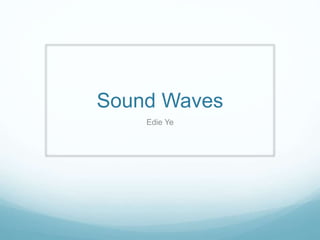
Presentation1
- 2. Sound Waves A sound wave is a longitudinal wave and a type of mechanical wave A sound wave travels through compressions and rarefactions
- 3. Connection to sound wave A sound wave behaves similar to other waves, so think about this: comparing the amplitudes of two sound waves, which sound wave would we expect to be louder, the one with a lower amplitude or the one with a higher amplitude? Now think about frequency, does it change with an increase in amplitude? It would be louder at the higher amplitude and the frequency would not change. The frequency doesn’t change because think about this: when you increase the volume of your iPod when you are listening to music, it happens seamlessly. Increasing the amplitude means increasing the sound and if the frequency had changed, wouldn’t there have been an interruption?
- 4. Clicker 1 Consider the diagram below. Where is pressure the highest? Where pressure is the highest, would the displacement be positive, at zero, or negative?
- 5. Clicker 1 a. at compression; positive b. at compression; negative c. at compression; zero d. at rarefaction; positive e. at rarefaction; zero
- 6. Clicker 1 Explained From the diagram, we can see that pressure is highest at compression. We can’t see the displacement however, but because we know for an area’s pressure to be high, both sides (i.e. left and right) must have particles pushed towards that area to create that high pressure and hence a balance which results with zero displacement. This is similar to velocity and displacement, where the displacement is at zero, the velocity is at its maximum. This is because both velocity vs. displacement, and pressure vs. displacement are out of phase by π/2 rad.
- 7. Clicker 2 Consider the diagram below. Where is pressure the lowest? Where pressure is the lowest, would the displacement be positive, at zero, or negative?
- 8. Clicker 2 a. at compression; positive b. at compression; negative c. at compression; zero d. at rarefaction; positive e. at rarefaction; zero
- 9. Clicker 2 Explained From the diagram, we can see that pressure is lowest at compression. We can’t see the displacement however, but similar to high pressure, it is at zero.
- 10. What is speed dependent on? Dependent on the fraction of volume change when we change pressure which is known as bulk modulus, B Equation for bulk modulus: B= -VΔp/ΔV, where ΔV is change in volume fraction and Δp is change in pressure Dependent on the density of the material Equation for speed of sound: v=√(B/p), where B is bulk modulus and p is density
- 11. Clicker 3 The speed of a sound wave is dependent on wavelength. a. true b. false
- 12. Clicker 3 Explained The speed of sound is is dependent on the equation: v=√(B/p) so it is independent from wavelength.
- 13. Clicker 4 Say the bulk modulus of unknown substance one (solid) is 4 x 107 and its density is 15 000. Say the bulk modulus of unknown substance two (liquid) is 4 x 105 and its density is 1 000. We can expect the velocity of unknown one to have a higher velocity than that of unknown two. a. true b. false
- 14. Clicker 4 Explained Although the effect of density decreases the speed of the sound, the increase in bulk modulus from gas to liquid to solid is greater than the density increase (in terms of ratio) and hence the trend is that the speed of sound in solids is usually (e.g. solid) greater than the speed of liquid (e.g. liquid). Calculation of unknown one: √[(4.0 x 107)/15 000] = 52 m/s Calculation of unknown two: √[(4.0 x 105)/1 000] = 20 m/s
- 15. Clicker 5 You are in a 50 meter swimming pool and there is a kid swimming about 30 meters inside the water away from their parent who is is yelling at the him to get out of the water (This happens occasionally at the pool and angry parents are very loud). The lifeguard is standing 25 away from the parent and you are standing 5 meters away from the parent. Who do we expect to hear the parent first? second? third?
- 16. Clicker 5 a. all at the same time b. you ;lifeguard; kid c. you and lifeguard at same time; kid d. lifeguard and kid at same time; you e. you; kid; lifeguard
- 17. Clicker 5 Explained We can expect you to hear the sound first because sound in water travels just over 4 times than that of air but because you are less than 4 times away you can hear the parent first. We can expect the kid to hear the sound second because although the kid is further away from the parent than the lifeguard, we expect the speed of sound to travel faster (just over 4 times) than that of air. We, then, can say the lifeguard hears it last.
- 18. Thank you for watching
- 19. Work Cited Hawkes, Robert, Javed Iqbal, Firas Mansour, Marina-Bolotin, and Peter Williams. Physics for Scientists and Engineers. Vol. 1. : Nelson, n.d. Print.